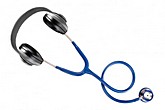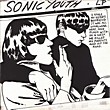|
|

From head to heart Following our retroscope series going on for several years, here we go again. Yes, for one more year! Here's Speakers' corner's cousin; From head to heart. Luna Kafé's focused eye on great events, fantastic happenings, absolute milestones, or other curious incidents from the historic shelves'n'vaults of pop'n'rock. Blowing our ears and our head, punching our chest and shaking our heart, or simply tapping our shoulder. Making us go sentimental, but not slaphappy. This moonth we present a 25-year-old, from around the year punk broke. For the second time. Here it goes: 'I know a secret or two about GooShe won't mind if I tell you She likes to wear green underwear And lays down most anywhere She doesn't have nothing to do And the boys say "Hey Goo, what's new?" My friend Goo goes "P.U." My friend Goo goes "P.U." I know a secret or two about Goo She won't mind if I tell you I know a secret or two about Goo I know a secret about Goo and you! And she sticks just like glue And the boys go "Hey Goo, what's new?" My friend Goo just goes "P.U." My friend Goo just goes "P.U." Goo goo goo Goo goo goo Goo goo goo, my friend Goo Goo goo goo, talkin' bout Goo Goo goo goo, my friend Goo Goo goo goo, you would too Goo!' ("My Friend Goo", Kim Gordon)
Sonic Youth For the time being I'm reading Kim Gordon's memoir book, Girl in a band, which opens with describing the stressful time from the band's final tour (in South America), after Gordon and Moore's split up. Their last gig took place in Sao Paulo, Brazil, on 14 November 2011. They closed their show with "Teen Age Riot". Teen-age spirit (and musically riotous) until the end. Anyway, this platter happened years earlier, when all was happiness, power and spirit. Grunge was new (still unknown to the masses). Sonic Youth were signed to major record label Geffen, and the band released their sixth album, Goo, on June 26 1990. SY had been a vital and central part of the US alternative rock scene since they appeared back in the early 80s. After riding with the indie labels (Homestead, SST, Enigma, as well as Moore's own Ecstatic Peace!) they landed a deal with DGC/Geffen, for a 'second start'. Mind you, they did not sell out (as some people probably was thinking). Goo marked the beginning of the mainstream breakthrough of alternative rock (and grunge), and the same year (or the year after) several contemporary bands made their major label debuts as well, like Alice in Chains' Facelift (Columbia); Screaming Trees' Uncle Anesthesia (1991, Epic); Temple of the Dog's Temple of the Dog (A&M, 1991); Nirvana's Nevermind (1991, Geffen); Pearl Jam's (from out of the ruins of Green River and Mother Love Bone) Ten (1991, Epic); Soundgarden's Badmotorfinger (1991, A&M). Not that SY relate to all these bands musically, except Nirvana. After Goo was released (to critical acclaim), SY toured Europe and the US twice that year. Among their touring friends were Nirvana, Dinosaur Jr., Babes in Toyland, Mudhoney and Gumball -- the 1991 tour was later to be chronicled in the documentary film 1991: The Year Punk Broke - but that is some other story. Or, rather: it all started with Goo. (Well, actually it all started when Warner Bros. courted and signed Hüsker Dü back in 1985, and eventually put out Candy Apple Grey the year after but that's some other story...) The classic line-up was Thurston Moore (guitar, vocals), Kim Gordon (bass, vocals, guitar), Lee Ranaldo (guitar, vocals), and (SY's 4th drummer, as he entered the band in 1985) Steve Shelley (drums). When asking SY fans which SY album is their favourite album, I guess there will be a line of titles. From their early albums, such as Bad Moon Rising (1985), EVOL (1986) and Sister (1987), to the possible and most likely fave, the iconic Daydream Nation (1988), via Goo and Dirty (1992), up to their 2000-era recordings. I guess some people will even list Ciccone Youth's one-off record. Well, I never understood or got into Daydream Nation. My friend is Goo (even though Dirty also ranks high). So, what's with Goo, then? "goo (uncountable): Could Goo also be described as 'sentimental sludge'? Sound wise, maybe, but... well... Maybe not. However, Daydream Nation has been hailed by many as their masterpiece. I prefer Goo, which was recorded (over a short period) in early 1990, at Sorcerer Sound Recording Studios and Greene St. Recording, NYC, with Daydream Nation producer Nick Sansano. Along with the quartet, some notable guests stepped inside the studio: Dinosaur Jr.'s J Mascis on backing vocals on "Tunic", "Mote" and "My Friend Goo", plus some additional production work as well; Velvet Monkeys'/B.A.L.L.'s/Gumball's Don Fleming (at the time a bandmate of Moore in Dim Stars, and later with The Backbeat Band) on backing vocals on "Dirty Boots" and "Disappearer", plus some additional production duties and additional percussion; kool man Himself, Public Enemy's Chuck D on additional vocals on "Kool Thing" (yes, of course). Opener "Dirty Boots" kick-started the album, but the album's lead single, "Kool Thing" was the koolest moment for many (check out the dead kool dance sequence from Hal Hartley's 1992 indie movie Simple Men). Anyway, "Dirty Boots" and "Disappearer" were also singles released from the album. Even though Goo presented more of Sonic Youth's dissonant sound, noisy guitars (with alternative strumming and tuning) and twisted, fucked up pop music, the album was described as the band's 'most accessible album' (by The Independent, UK). I find the album to be very appealing from the opening song to the closing moment ("Titanium Exposé"). There's an extreme tension and enthusiasm throughout the album which makes the songs shake and tremble with energy and power in all their simplicity. To me, Lee Ranaldo's "Mote" is (one of) the master track(s). 7 minutes, 37 seconds of power, and halfway through it the experimental and vibrant noise cascades start. But, hey there are many favourites in here: Moore's tense and wild "Mildred Pierce", the aforementioned "Dirty Boots", "Kool Thing" and Gordon's "Tunic (Song for Karen)" - about the (long since) late Karen Carpenter - or, the tragedy of Karen C. Not to forget "Cinderella's Big Score", or "Titanium Exposé", or.... the whole, the full album -- the album in total. 25 years on, Goo is still burning, steaming and heating - quickly and slowly... but it never fades. This is the sound of a true, modern classic. My friend, Goo. PS! A two-disc/four-LP deluxe edition of Goo was released in 2005. This edition held outtakes, demos and live tracks. A number of the 8-track demos was included, with their working titles such as "DV2" (Kool Thing), "Number One" (Disappearer)", "Corky" (Cinderella's Big Score), "Bookstore" (Mote), "Animals" (Mary-Christ), and "Blowjob" (Mildred Pierce), as well as a couple of cover versions: The Beach Boys' "I Know There's an Answer", and "That's All I Know (Right Now)" which is a cover of early 70s NYC punk band Neon Boys (featuring Tom Verlaine, Richard Hell and Billy Ficca, later to appear in/to form Television, Richard Hell and the Voidoids, and Johnny Thunders' The Heartbreakers). Copyright © 2015 Håvard Sonic Oppøyen
|
| You may also want to check out our Sonic Youth articles/reviews: Murray Street, Sacred Trickster, The Eternal. |
| © 2015 Luna Kafé |
